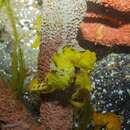Diagnostic Description
provided by Fishbase
Description: (based on 39 specimens): Adult height: 9.5-17.5cm. Rings: 11+35 (31-39). Snout length: 2.2 (2.0-2.5) in head length. Dorsal fin rays: 17 (16-19) covering 2+1 rings. Pectoral fin rays: 16 (15-17). Coronet: low-medium, rounded, may be quite large and convoluted (like a crumpled piece of paper). Spines: none to low rounded tubercles. Other distinctive characters: broad, almost double cheek and eye spines; long, thick snout; narrow body; usually no skin appendages.Color pattern: often profusely spotted with brown, with numerous tiny white dots (especially on tail); may have paler âsaddlesâ across dorsolateral surfaces.
- Recorder
- Cristina V. Garilao
Life Cycle
provided by Fishbase
Breeding season more than 8 months in laboratory; egg diameter 1.2 mm; gestation period 2 weeks, depending on water temperature; young approximately 7 mm at birth; pair-bonded in wild (Ref. 30915). Monogamous mating is observed as both obligate and genetic (Ref. 52884).
Morphology
provided by Fishbase
Dorsal spines (total): 0; Dorsal soft rays (total): 1619
- Recorder
- Cristina V. Garilao
Trophic Strategy
provided by Fishbase
Also found among sponges (Ref. 52034).
Biology
provided by Fishbase
Uncommon in most areas, but may be locally common in certain places. Usually attached to gorgonians or seagrasses but may occur in floating Sargassum or swimming freely in midwater (Ref. 9710). Ovoviviparous (Ref. 205). The male carries the eggs in a brood pouch which is found under the tail (Ref. 205). Has been reared in captivity (Ref. 35409). Length type refers to Height (= from top of coronet to the tip of straightened tail).
Importance
provided by Fishbase
fisheries: minor commercial; price category: unknown; price reliability:
Slender seahorse
provided by wikipedia EN
The slender seahorse or longsnout seahorse (Hippocampus reidi) is a species of fish in the family Syngnathidae[3] that usually inhabits subtropical regions.
Description
The slender seahorses have a gestation period of around two weeks and typically grow to be approximately 6.8 inches long (17.5 centimeters), while the mean height of juvenile slender seahorses is only around 8.2 millimeters.[4] Males are usually orange, while the females are yellow. However, both males and females may have brown or white spots placed sporadically upon their body. These spots may also change into a pink or white color during the courtship period.[5]
Habitat and distribution
The slender seahorse has been found at depths of 55 meters (180 feet). Smaller individuals inhabit shallower waters. The slender seahorse has an affinity for coral reefs[5] and seagrass beds and can be found on gorgonian coral, seagrass, mangroves, and Sargassum. It is native to many countries, including the Bahamas, Barbados, Belize, Bermuda, Brazil, Colombia, Cuba, Grenada, Haiti, Jamaica, Panama, United States (Florida and North Carolina), and Venezuela.[1] It inhabits subtropical regions, ranging from 29 degrees north to 25 degrees south and 133 degrees west to 40 degrees east.[3] Many H. reidi reside near China and more so in Brazil but in both areas they are at a risk of becoming an endangered species. In China these seahorses are used for trade and for traditionally Chinese medication, while in Brazil they are part of a large trading, involving the commercial extraction of 25 million seahorses per year.[6]
Naming
The specific name honors Earl D. Reid of the Division of Fishes at the Smithsonian Institution.[7]
References
-
^ a b Oliveira, T.; Pollom, R. (2017). "Hippocampus reidi". IUCN Red List of Threatened Species. 2017: e.T10082A17025021. doi:10.2305/IUCN.UK.2017-3.RLTS.T10082A17025021.en. Retrieved 14 November 2021.
-
^ "Appendices | CITES". cites.org. Retrieved 2022-01-14.
-
^ a b Froese, R.; Pauly, D. (6 October 2010). "FishBase".
-
^ Hora, Maik (16 Mar 2009). "Closing the reproductive cycle: Growth of the seahorse Hippocampus reidi (Teleostei, Syngnathidae) from birth to adulthood under experimental conditions". Aquaculture. 292 (1–2): 39. doi:10.1016/j.aquaculture.2009.03.023.
-
^ a b "Slender seahorse". Monterey Bay Aquarium. Archived from the original on 2012-07-21.
-
^ Cividanes da Hora, Maik dos Santos (July 1, 2009). "Closing the reproductive cycle: Growth of the seahorse Hippocampus reidi (Teleostei, Syngnathidae) from birth to adulthood under experimental conditions". Science Direct. Retrieved October 14, 2020.
{{cite web}}: CS1 maint: url-status (link) -
^ Isaac Ginsburg (1933). "Descriptions of five new species of seahorses". Journal of the Washington Academy of Sciences. 23 (12): 560–563.

- license
- cc-by-sa-3.0
- copyright
- Wikipedia authors and editors
Slender seahorse: Brief Summary
provided by wikipedia EN
The slender seahorse or longsnout seahorse (Hippocampus reidi) is a species of fish in the family Syngnathidae that usually inhabits subtropical regions.
- license
- cc-by-sa-3.0
- copyright
- Wikipedia authors and editors
Distribution
provided by World Register of Marine Species
Western Atlantic: North Carolina in USA, Bermuda and Bahamas to Rio deJaneiro, Brazil.
North-West Atlantic Ocean species (NWARMS)
- license
- cc-by-4.0
- copyright
- WoRMS Editorial Board
Habitat
provided by World Register of Marine Species
benthic
North-West Atlantic Ocean species (NWARMS)
- license
- cc-by-4.0
- copyright
- WoRMS Editorial Board

